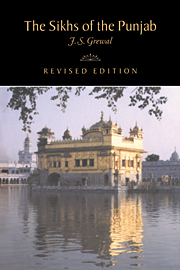Book contents
- Frontmatter
- Introduction
- 1 The Turko-Afghan Rule
- 2 Foundation of the Sikh Panth
- 3 Evolution of the Sikh Panth (1539–1606)
- 4 Transformation of the Sikh Panth (1606–1708)
- 5 Rise to political power (1708–1799)
- 6 The Sikh empire (1799–1849)
- 7 Recession and resurgence (1849–1919)
- 8 In the struggle for freedom (1920–1947)
- 9 Towards the ‘Punjabi Province’ (1947–1966)
- 10 In the new Punjab state (1966–1984)
- Bibliographical essay
- Index
- THE NEW CAMBRIDGE HISTORY OF INDIA
- References
9 - Towards the ‘Punjabi Province’ (1947–1966)
Published online by Cambridge University Press: 28 March 2008
- Frontmatter
- Introduction
- 1 The Turko-Afghan Rule
- 2 Foundation of the Sikh Panth
- 3 Evolution of the Sikh Panth (1539–1606)
- 4 Transformation of the Sikh Panth (1606–1708)
- 5 Rise to political power (1708–1799)
- 6 The Sikh empire (1799–1849)
- 7 Recession and resurgence (1849–1919)
- 8 In the struggle for freedom (1920–1947)
- 9 Towards the ‘Punjabi Province’ (1947–1966)
- 10 In the new Punjab state (1966–1984)
- Bibliographical essay
- Index
- THE NEW CAMBRIDGE HISTORY OF INDIA
- References
Summary
To the task of framing a constitution for free India was added the problem of resettlement and rehabilitation almost immediately upon Independence. The integration of princely states with the Indian Union too was urgent. Equally important were a long-term territorial reorganization and economic growth. The politics of the Sikhs in the early decades of Independence were linked up with these major issues.
The political decision to partition the subcontinent into two sovereign states resulted eventually in the largest transfer of population known to history. Nearly a million persons perished, and over 13 million crossed the borders. Over 4 million refugees from West Pakistan crossed into the Punjab and a larger number of Muslims from the Indian side went to Pakistan. In 1951, when the total population of the Indian Punjab was over 12½ millions, there were nearly 2½ million refugees, forming a fifth of its population.
Resettlement of refugees became the most urgent task of the new governments. The Indian Government retained the responsibility of rehabilitating urban refugees, delegating the responsibility of rehabilitating rural refugees in the Punjab to the Punjab Government. The non-Muslim landowners, who had left 5,700,000 acres of land in the West Punjab, had to be settled on 4,500,000 acres left by Muslim landowners in the East Punjab. The government evolved a scheme of graded cuts by which the refugees lost land in increasing proportion to the size of their holdings, putting a virtual end to large landholdings.
- Type
- Chapter
- Information
- The Sikhs of the Punjab , pp. 181 - 204Publisher: Cambridge University PressPrint publication year: 1991

